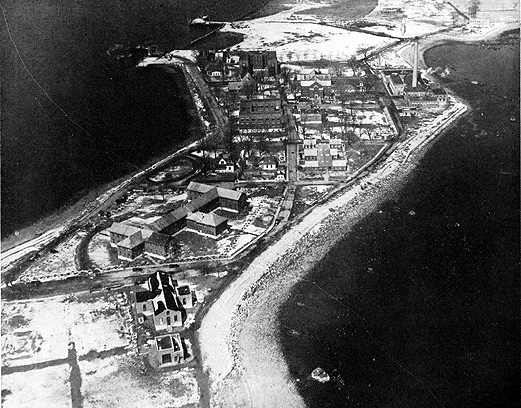Aerial photo has been 'mapped" into 6 sections. Click a section to access its linked close-up view.

[Aerial image appears atop Page 50 of NYC DOC's 1954 annual report digest with the following caption information: ]

THE CITY OF NEW YORK HART ISLAND EDWARD DROS Warden Hart Island, consisting of approximately 100 acres, is located at the foot of Fordham Street in Bronx County, east of City Island and at the northern point of Long Island Sound. In 1868 the island contained some old buildings used for the detention of incorrigible children. Some years later this project was abandoned and the institution was converted into an asylum for the insane.
In 1895 the Department of Correction acquired the Hart Island institution and established a Branch Workhouse for aged men, drug addicts whose general health had been impaired, prisoners who had undergone surgical operations and others who were serving short terms. In 1905 the Department also established a reformatory at Hart Island for young offenders known as a “Reformatory for Misdemeanants.”* The housing and commingling of both adults and young offenders resulted in a complete lack of segregation and treatment programs for the adolescents. This situation was rectified on March 8, 1914, when the first transfer was made of the adolescent group from Hart Island to New Hampton Reformatory.
This necessitated the unsound policy of commingling Workhouse and Penitentiary inmates. Upon this Department's recommendation, the Board of Estimate adopted a Resolution on February 23, 1950. authorizing the release of Hart Island to the Department of Welfare to be used for a rehabilitation center for homeless men. The administrative decision to release Hart Island to the Department of Welfare, which was effected by July 13, 1950, was based on the assumption that the facilities on Rikers Island would accommodate a steadily increasing prison inmate population. As the growth of the sentenced inmate population began to exceed the housing capacity during the early part of 1954, the inadequacy of the Rikers Island facilities became apparent. As a result, Hart Island was restored to us on August 17, 1954. The population of the Penitentiary and Workhouse on Rikers Island reached the all-time high of 3,759 inmates on August 20, 1954, even though the rated capacity for the Penitentiary was 1,887 and that of the Workhouse 1,000. On August 20, 1954, with an inmate population at the Rikers Island Workhouse totaling 2,066, there was an immediate transfer of 208 inmates to Hart Island. On December 30, 1954, the census of Hart Island was 514 and as housing facilities are steadily reactivated there, such transfers will continue to be made. A program of physical repair, utilizing both inmate labor projects and contract projects, is now under way. A sum of $300,000 has been allocated for repairs. When completed, the institution will house a minimum of 1,560 adult short-term prisoners in four groupings:
There is ample opportunity for prison labor in maintenance and repair since this institution still requires extensive physical alterations.
The Santa Claus Toy Repair Workshop was again introduced for the repair of damaged, antiquated toys, which are then distributed to the needy children of New York by the Police Athletic League (PAL) of the Police Department. Other handicrafts and manual productions are conducted in this large workshop, primarily by the geriatric group. The workshop's productivity for the year 1954 was as follows:
Many quiet games were distributed for the inmate population; a craft project program was begun; art instruction was instituted; radios were supplied for each dormitory area; library facilities were opened and specific recreational areas were designated. Plans are in the offing to convert unused outdoor sections into recreational areas for all the athletic activities. The departmental Social Service Unit is attempting to serve the aged and homeless prisoner here during his stay and upon his release makes contacts with the Department of Welfare and other social agencies for housing, job placement, or hospitalization. A Separation Unit is in process of being instituted with the cooperation of the Department of Welfare . * Chapter 305 of the Laws of 1905 with an amendment under Chapter 516 of the Laws of 1907 limiting commitments to first offenders 16 - 30 years of age.
WEBMASTER NOTE: Elsewhere on this site are several presentations showing other aerial photos of Hart Island as well as other detail images -- both b&w and in color -- of buildings and locales noted in this presentation's close-up section images and captions. A number of these older photo presentations grew out of history tours, a program long discontinued.
-- To NYCHS
home page --
|